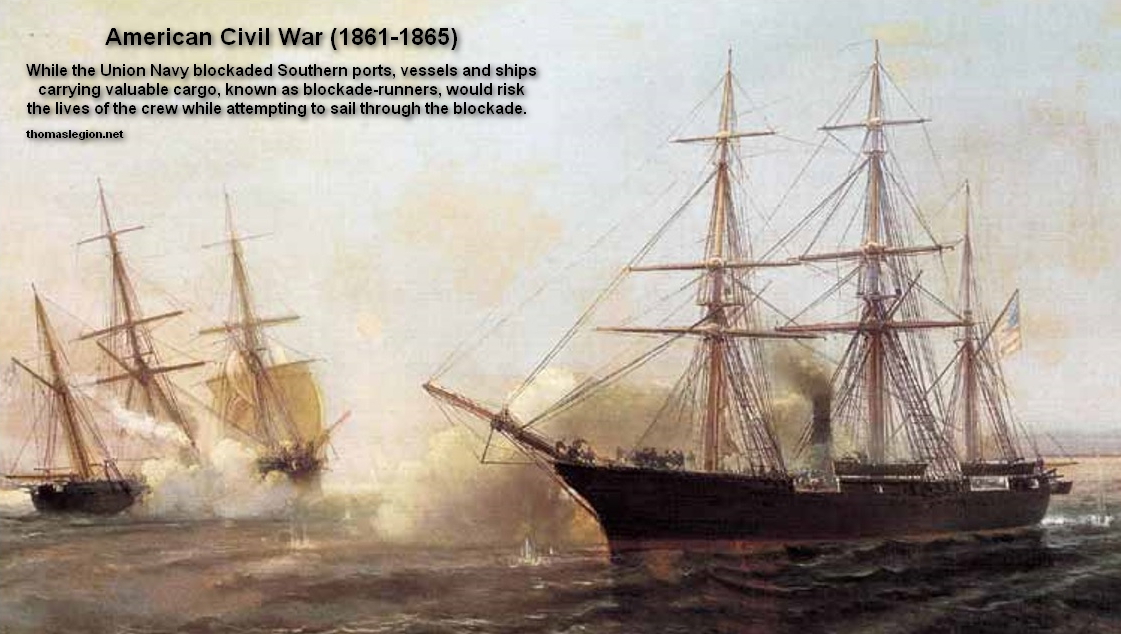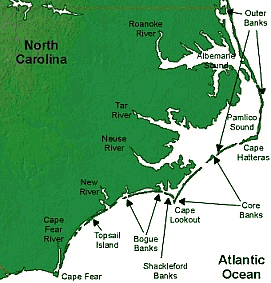|
Battle of Forts Clark and Hatteras
North Carolina Coast and the Civil War
Hatteras Inlet Batteries
Other Names: Battle of Forts Clark and Hatteras; Battle of Hatteras
Inlet
Location: Dare County
Campaign: Blockade of the Carolina Coast (August-December 1861)
Date(s): August 28-29, 1861
Principal Commanders: Maj. Gen. Benjamin F. Butler [US]; Col.
William F. Martin [CS]
Forces Engaged: 9th and 20th New York regiments (est. 2,000)
[US]; Hatteras Island Garrison (900) [CS]
Estimated Casualties: 718* total (US 3; CS 715)
Result(s): Union victory
| Battle of Hatteras Inlet |

|
| North Carolina Coast and the Civil War |
| A Critical Defense on the NC Outer Banks |

|
| Civil War on the Outer Banks of North Carolina |
Description: On August 26, an amphibious expedition led by Maj.
Gen. Benjamin Butler and Flag-Officer Silas Stringham, embarked from Fort Monroe to capture Hatteras Inlet, an important haven
for blockade-runners. The blockade of North Carolina's coast, which included the assault on Forts Clark and Hatteras, was a
strategic objective in Gen. Winfield Scott's Anaconda Plan.On the 28th, while the navy bombarded Forts Clark and Hatteras, Union
troops came ashore and attacked the rear of the Confederate batteries. On
August 29, whereas Col. William F. Martin surrendered the Confederate garrison of 670, the Federals lost only one man.
Butler next returned to Fort Monroe, leaving the captured forts garrisoned. This movement was part of Union efforts to seize
coastal enclaves from which to enforce the Federal blockade. During
World War II, because of the numerous allied ships sunk by German U-boats, the waters off Cape Hatteras became known as Torpedo Alley.
*Depending on the source, casualty figures vary slightly.
Sources: National Park Service; Official Records of the Union and Confederate
Armies; Official records of the Union and Confederate Navies in the War of the Rebellion.
Recommended Reading: The
Civil War in Coastal North Carolina (175 pages) (North Carolina Division of Archives and History). Description: From the drama of blockade-running to graphic descriptions of battles
on the state's islands and sounds, this book portrays the explosive events that took place in North Carolina's
coastal region during the Civil War. Topics discussed include the strategic importance of coastal North Carolina, Federal occupation of coastal areas, blockade-running, and the impact of
war on civilians along the Tar Heel coast.
Recommended
Reading: Portrait of the Past : The Civil War
on Hatteras Island North Carolina (Portrait of the Past) (Hardcover). Description:
Hatteras Island has achieved a well-deserved reputation as a summer getaway and a wildlife refuge on North Carolina's coast.
However, most visitors are unaware of the crucial role that Hatteras played in the Civil War. The book offers a new view of
Hatteras's history, interweaving historical facts, archival drawings, and current photography of how the island looks today.
Continued below…
In addition, the book reveals
the largely unknown journals of Edwin Graves Champney, a Union soldier who was stationed on Hatteras from 1862 to 1863. Champney's
prose and artistic talents, along with the quotes of soldier Charles F. Johnson of the Ninth New York, shed new light on the
experiences of Civil War soldiers stationed on the Outer Banks during that time. It follows the crucial maritime battles along
the Outer Banks and the famous Burnside Expedition. This is a fascinating history of how one of America's
most treasured islands played a significant part in the Civil War and is a must for any reader. About
the Author: Author: Drew Pullen is a graduate of Houghton College and a former history teacher. He currently manages the Hatteras and Ocracoke
offices of the East Carolina Bank. As an amateur historian, he has written several articles on the Civil War for local newspapers.
His wife Jo Anne is from a local Hatteras family and her great-great grandfather was stationed at Fort Hatteras during the Civil War. Drew continues
to research Civil War action in eastern North Carolina for
future books.
Recommended Reading: The
Civil War on the Outer Banks: A History of the Late Rebellion Along the Coast of North Carolina from Carteret to Currituck
With Comments on Prewar Conditions and an Account of (251 pages). Description: The ports at Beaufort, Wilmington, New Bern and Ocracoke, part of the Outer Banks (a chain
of barrier islands that sweeps down the North Carolina coast from the Virginia Capes to Oregon Inlet), were strategically
vital for the import of war materiel and the export of cash producing crops. From official records, contemporary newspaper
accounts, personal journals of the soldiers, and many unpublished manuscripts and memoirs, this
is a full accounting of the Civil War along the North Carolina
coast.
Recommended Reading: Storm
over Carolina: The Confederate Navy's Struggle for Eastern North Carolina. Description: The struggle for control of the eastern
waters of North Carolina during the War Between the States
was a bitter, painful, and sometimes humiliating one for the Confederate navy. No better example exists of the classic adage,
"Too little, too late." Burdened by the lack of adequate warships, construction facilities, and even ammunition, the
South's naval arm fought bravely and even recklessly to stem the tide of the Federal invasion of North
Carolina from the raging Atlantic. Storm
Over Carolina is the account of the Southern navy's struggle in North
Carolina waters and it is a saga of crushing defeats interspersed with moments of brilliant and even
spectacular victories. It is also the story of dogged Southern determination and incredible perseverance in the face
of overwhelming odds. Continued below...
For most of
the Civil War, the navigable portions of the Roanoke, Tar, Neuse, Chowan, and Pasquotank rivers were
occupied by Federal forces. The Albemarle and Pamlico sounds, as well as most of the coastal towns and counties, were also
under Union control. With the building of the river ironclads, the Confederate navy at last could strike a telling blow against
the invaders, but they were slowly overtaken by events elsewhere. With the war grinding to a close, the last Confederate vessel
in North Carolina waters was destroyed. William T. Sherman
was approaching from the south, Wilmington was lost, and the
Confederacy reeled as if from a mortal blow. For the Confederate navy, and even more so for the besieged citizens of eastern
North Carolina, these were stormy days indeed. Storm Over Carolina describes their story, their struggle, their history.
Recommended
Reading: Seacoast Fortifications of the United States: An Introductory History. Reader’s Review: In the thirty years since this book was published, one always
hoped another would equal or surpass it. None has, or perhaps ever will. It is a marvelous history of the Forts along the
American Seacoast, both Atlantic and Pacific, and even the Philippines.
…Any Fort enthusiast must read this book. The author captures so much information, so many views, so much perspective
in so few pages, the book is breathtaking. It is easily the finest book on its chosen subject, which is why it never goes
out of print. “If forts interest you, read it, period.” Continued below...
The photographs from the author's collection, the army's files, the National
Archives, etc., make it an invaluable edition. But the text, the clear delineation of the periods of fort building since 1794
in the US, and the differentiation of the periods, are so worth while. Ray manages to
be both terse, and pithy. It is a great tribute to any author to say that. “This is a MUST read for anyone interested
in the subject, even one only interested in their own local Fort, and how it relates to the defense plans of the United States
when it was built.” “[T]here is NO better book to read on the subject.”
Recommended Reading: Ironclads and Columbiads: The Coast
(The Civil War in North Carolina) (456 pages). Description: Ironclads and Columbiads covers some of the most
important battles and campaigns in the state. In January 1862, Union forces began in earnest to occupy crucial points on the
North Carolina coast. Within six months, Union army and
naval forces effectively controlled coastal North Carolina from the Virginia
line south to present-day Morehead City.
Union setbacks in Virginia, however, led to the withdrawal of many federal soldiers from North Carolina, leaving only enough
Union troops to hold a few coastal strongholds—the vital ports and railroad junctions. The South during the Civil War,
moreover, hotly contested the North’s ability to maintain its grip on these key coastal strongholds.
Battle of Hatteras Inlet: An Island History, Fort Hatteras Battery Map, Fort Hatteras Inlet North Carolina
Coast, Hatteras Inlet Battery Photo, Fort Hatteras Island Inlet and Batteries, Hatteras Battery Civil War History.
|

